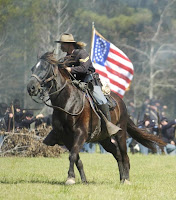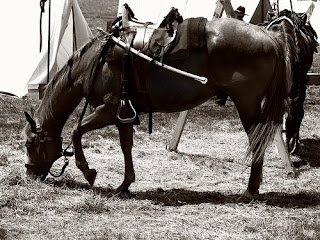I received the following from an old friend who is an ACW Calvary reenactor and a military historian. He found the comment 0f 25 pounds of forage per horse to be excessive. Here is the comment he sent me. I am keeping it anomymous for reasons that will be obvious once you read it.
Being in to horses, I must comment that when I read the history of logistics piece

included on your web site, I was astonished to learn that the average grain allotment for U.S. army horses was 25 pounds per day! I must say, believe it was the lucky cavalry horse indeed that received that amount of grain on a regular (or irregular) basis, and if such a beast was not working hard for at least 16 hours straight pulling a heavy load or walking/trotting/cantering, surely that much grain would soon founder the animal, especially if it were not used to eating that much grain on a regular basis. In the wild, horses do not even eat grain. We feed it so they have the energy to work hard for us. Hard working draft horses weighing 3000 pounds might need that much, but a 1000 pound cav mount probably does not. I have a personal story in this regard:
A few years ago one of my horses, 1100 pounds and ridden almost every day at the time, got into a bag of grain (50 #) when I accidently left the tack room door open overnight. It ate about half the bag, then even it had had quite enough.
Next morning, an emergency vet visit was required to save the bloated and moaning beast, which could not be kept on its feet. Consternation spread throughout the land- all my fault! After a half-hour with a hose pushed way down its throat pumping castor oil and water into its system, the very displeased horse seemed not to be quite so distressed. Prior to this intense waterboarding procedure, the vet had to insert her arm way up the horse's ass to pull out impacted grain and hay. Horses can't regurgitate, so there is only one way to remove anything that gets stuck in their digestive systems. Under heavy criticism for my negligence, I had just finished fashioning a noose from a lead rope in order to end MY suffering, when the horse jumped up, dazed, pissed-off, but recovered.



No comments:
Post a Comment